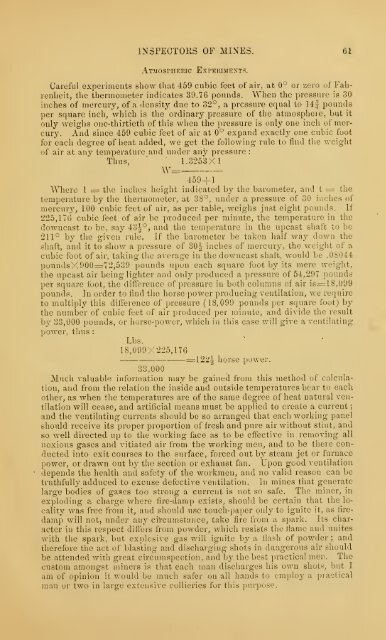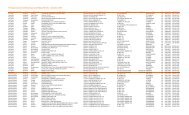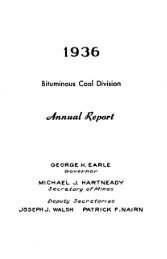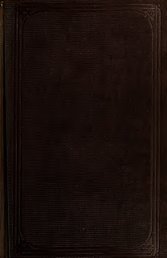Reports of the Inspectors of Mines of the anthracite coal regions of ...
Reports of the Inspectors of Mines of the anthracite coal regions of ...
Reports of the Inspectors of Mines of the anthracite coal regions of ...
Create successful ePaper yourself
Turn your PDF publications into a flip-book with our unique Google optimized e-Paper software.
INSPECTORS OF MINES. 61<br />
Atmospheric Experiments.<br />
Careful experiments show that 459 cubic feet <strong>of</strong> air, at 0° or zero <strong>of</strong> Fahrenheit,<br />
<strong>the</strong> <strong>the</strong>rmometer indicates 39.76 pounds. When <strong>the</strong> pressure is 30<br />
inches <strong>of</strong> mercury, <strong>of</strong> a density due to 32°, a pressure equal to 14 J pounds<br />
per square inch, which is <strong>the</strong> ordinary pressure <strong>of</strong> <strong>the</strong> atmosphere, but it<br />
only weighs one-thirtieth <strong>of</strong> this when <strong>the</strong> pressure is only one inch <strong>of</strong> mercury.<br />
And since 459 cubic feet <strong>of</strong> air at 0° expand exactly one cubic foot<br />
for each degree <strong>of</strong> heat added, we get <strong>the</strong> following rule to find <strong>the</strong> weight<br />
<strong>of</strong> air at any temperature and under any pressure :<br />
Where 1<br />
Thus, 1.3253X1<br />
W=<br />
459+1<br />
= <strong>the</strong> inches height indicated by <strong>the</strong> barometer, and t = <strong>the</strong><br />
temperature by <strong>the</strong> <strong>the</strong>rmometer, at 38°, under a pressure <strong>of</strong> 30 inches <strong>of</strong><br />
mercury, 100 cubic feet <strong>of</strong> air, as per table, weighs just eight pounds. If<br />
225,11(3 cubic feet <strong>of</strong> air be produced per minute, <strong>the</strong> temperature in <strong>the</strong><br />
downcast to be, say 43|°, and <strong>the</strong> temperature<br />
211° by <strong>the</strong> given rule. If <strong>the</strong> barometer be<br />
in <strong>the</strong> upcast shaft to be<br />
taken half way down <strong>the</strong><br />
shaft, and it to show a pressure <strong>of</strong> 30| inches <strong>of</strong> mercury, <strong>the</strong> weight <strong>of</strong> a<br />
cubic foot <strong>of</strong> air, taking <strong>the</strong> average in <strong>the</strong> dov^nicast shaft, would be .08044<br />
poundsX900=72,539 pounds upon each square foot by its mere weight,<br />
<strong>the</strong> upcast air being lighter and only produced a pressure <strong>of</strong> 54,297 pounds<br />
per square foot, <strong>the</strong> difference <strong>of</strong> pressure in both columns <strong>of</strong> air is=18,099<br />
pounds. In order to find <strong>the</strong> horse power producing ventilation, we require<br />
to multiply this difference <strong>of</strong> pressure (18,099 pounds per square foot) by<br />
<strong>the</strong> number <strong>of</strong> cubic feet <strong>of</strong> air produced per minute, and divide <strong>the</strong> result<br />
by 33,000 pounds, or horse-power, which in this case v;ill give a ventilating<br />
power, thus :<br />
Lbs.<br />
18,099X225,176<br />
=122i horse power.<br />
33,000<br />
Much valuable information may be gained from this method <strong>of</strong> calculation,<br />
and from <strong>the</strong> relation <strong>the</strong> inside and outside temperatures bear to each<br />
o<strong>the</strong>r, as when <strong>the</strong> temperatures are <strong>of</strong> <strong>the</strong> same degree <strong>of</strong> heat natural ventilation<br />
will cease, and artificial means must be applied to create a current<br />
and <strong>the</strong> ventilating currents should be so arranged that each working panel<br />
should receive its proper proportion <strong>of</strong> fresh and pure air without stint, and<br />
so well directed up to <strong>the</strong> working face as to be effective in. removing all<br />
noxious gases and vitiated air from <strong>the</strong> working men, and to be <strong>the</strong>re conducted<br />
into exit courses to <strong>the</strong> surface, forced out by steam jet or furnace<br />
power, or drawn out by <strong>the</strong> section or exhaust fan. Upon good ventilation<br />
depends <strong>the</strong> health and safety <strong>of</strong> <strong>the</strong> workmen, and no valid reason can be<br />
truthfully adduced to excuse defective ventilation. In mines that generate<br />
large bodies <strong>of</strong> gases too strong a current is not so safe. The miner, in<br />
exploding a charge where fire-damp exists, should be certain that <strong>the</strong> locality<br />
was free from it, and should use touch-paper only to ignite it, as firedamp<br />
will not, under any ciVcumstance, take fire from a spark. Its character<br />
in this respect differs from powder, which resists <strong>the</strong> fiame and unites<br />
with <strong>the</strong> spark, but explosive gas will ignite by a fiash <strong>of</strong> powder ; and<br />
<strong>the</strong>refore <strong>the</strong> act <strong>of</strong> blasting and discharging shots in dangerous air should<br />
be attended with great circumspection, and by <strong>the</strong> best practical men. The<br />
custom amongst miners is that each man discharges his own shots, but I<br />
am <strong>of</strong> opinion it would be much safer on all hands to employ a practical<br />
man or two in large extensive collieries for this purpose.<br />
;




![1945 Anthracite Annual Report Districts 19 - 25 [Adobe pdf - 9148Kb]](https://img.yumpu.com/50308099/1/190x119/1945-anthracite-annual-report-districts-19-25-adobe-pdf-9148kb.jpg?quality=85)


![1937 Anthracite Annual Report Districts 1 - 11 [Adobe pdf - 9394Kb]](https://img.yumpu.com/43539962/1/190x119/1937-anthracite-annual-report-districts-1-11-adobe-pdf-9394kb.jpg?quality=85)







![1931 Anthracite Annual Report Districts 1 - 11 [Adobe pdf - 8007Kb]](https://img.yumpu.com/39427789/1/190x119/1931-anthracite-annual-report-districts-1-11-adobe-pdf-8007kb.jpg?quality=85)

